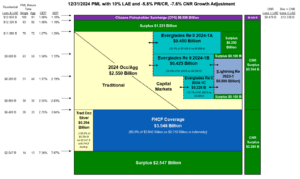Life insurance sector unprepared for US$7.8 trillion shift in next two decades

Life insurance sector unprepared for US$7.8 trillion shift in next two decades | Insurance Business Australia
Insurance News
Life insurance sector unprepared for US$7.8 trillion shift in next two decades
New report unveils the need for new partnerships amid demographic shift
Insurance News
By
Kenneth Araullo
A new report from Capgemini Research Institute reveals that the global life insurance sector is not ready for a trillion-dollar shift in the coming decades.
According to the World Life Insurance Report 2023, a significant shift is on the horizon for life insurers considering an impending outflow of assets under management (AUM) ahead of the largest inter-generational wealth transfer in history. At present, policyholders aged over 65 own 40% of insurers’ AUM, amounting to a total of US$7.8 trillion for the 40 largest global life insurers. The report predicts that these assets will be transferred to beneficiaries by 2040.
The United Nations forecasts that by 2050, 33% of the world’s population will be over the age of 50. However, most senior citizens lack a financial plan for successful ageing, and as highlighted in Capgemini’s new report, 60% of individuals aged 65 or older have not sought professional financial advice to prepare for retirement or transfer their wealth.
As people nearing retirement face increased financial responsibility for successful ageing due to unique economic challenges, declining governmental support, and rising healthcare costs, there is a greater need for life insurance. However, consumers encounter growing obstacles to product adoption. Policyholders cite complexity across life insurance offerings and limited awareness (39%) as the primary hurdles, followed by a lack of trust (29%).
“The demographic shift coupled with the greatest wealth transfer to take place in the coming years threaten the life insurance industry, as it competes to serve the needs of an ageing population. To help policyholders age well, carriers must find a way to appeal to the evolving needs of consumers by creating a personalised and tailored experience through more innovative product design,” Capgemini global leader for life, annuity and benefits sector Samantha Chow said.
New partnerships will be integral
The most significant challenge life insurers face presently is the challenge of remaining relevant amid this substantial wealth transfer. To safeguard the assets under management at risk, the report advocates prioritising affluent and mass affluent consumers who hold 39% of global wealth and constitute about 20% of the ageing population. This segment has the most significant need for ageing-well solutions, with over 75% seeking innovative life products. However, only 27% of insurers possess advanced product development capabilities to cater to them.
According to the report, over 44% of affluent and mass affluent customers aged 50 and above expect their insurers to offer services ranging from wellness initiatives to assisted living. Ecosystem partnerships will be critical for insurers to close this gap by coordinating a vast array of value-added services.
As insurers navigate the road ahead, they must also find a way to protect assets and boost growth. The report outlines a journey that will shift insurers from today’s product-centric approach to an operating model centred around customer-centricity, offering comprehensive, higher-value solutions designed to assist consumers in ageing well.
This transition necessitates an evolution of the value chain focused on improving the customer onboarding process and promoting policyholder and beneficiary engagement. Consequently, beneficiaries can evolve into new customers, and claims can effectively be converted into opportunities for revenue generation.
To commence, insurers can consolidate data to attain a single view of the customer and digitally empower agents by utilising artificial intelligence, including generative AI, to provide hyper-personalised advice. However, only 21% of insurers possess tools for advanced data analytics capabilities, and fewer (19%) leverage advanced technologies to streamline operations, enhance experiences, integrate across emerging ecosystems, and make faster and more data-driven decisions.
Insurers can also bolster policyholder and beneficiary engagement to deepen customer relationships by simplifying and personalising the onboarding journey, enhancing the claims experience through flexible claims restructuring, and capturing a single view of the customer by modernising their technology layer.
“Ecosystem partnerships, such as engaging with firms that specialise in serving seniors, can help insurers orchestrate value-added services and close their capabilities gap in key areas. Those that prioritise early engagement with clients and their beneficiaries will generate trust and safeguard their assets,” Chow said.
What are your thoughts on this story? Please feel free to share your comments below.
Related Stories
Keep up with the latest news and events
Join our mailing list, it’s free!







